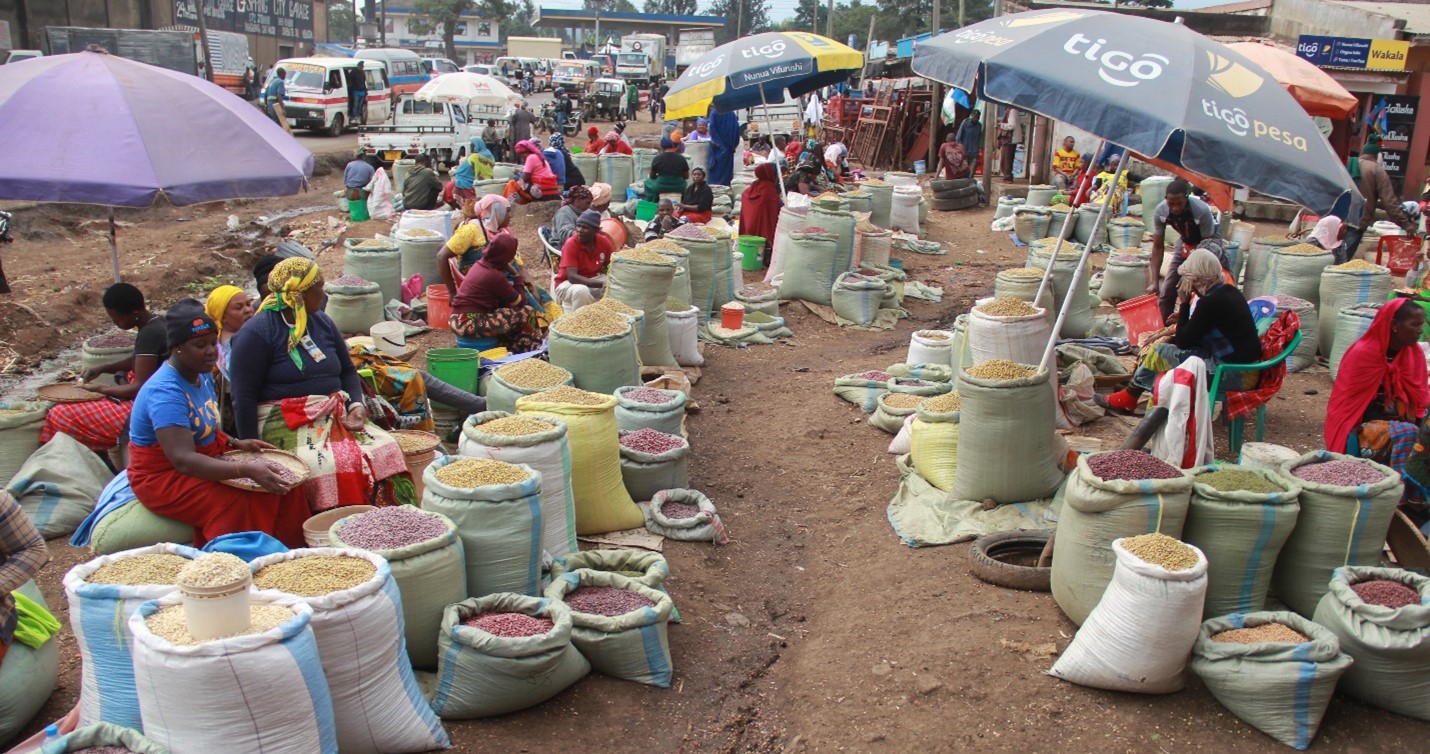by Radegunda Kessy, Sylvia Kalemera, Nestory Shida Fadhili Kasubiri, Agness Ndunguru, Mary Ndimbo, Mary Mdachi, Julius Mbiu, Jean Claude Rubyogo and Patricia Onyango
Common bean (Phaseolus vulgaris) plays a key role in the livelihoods of smallholder farmers in Tanzania as a food and nutrition security crop and a source of income. It is the leading legume crop, accounting for 78% of areas under cultivated land. 5,803,747 households in rural Tanzania depend on beans for their daily food figure 1. Per capita bean consumption is estimated at 19.3 kg per person per year. Tanzania produces an estimated 1.2 million tons of beans annually, making the country, the top bean producer in Africa and seventh globally. About 48 percent of bean production is sold her neighboring countries (such as Burundi, DRC, Kenya, Malawi Rwanda, South Africa, Uganda, and Zambia) and the quantity exported has been growing at an average annual rate of 10percent since 2005 (Enid et al 2019).
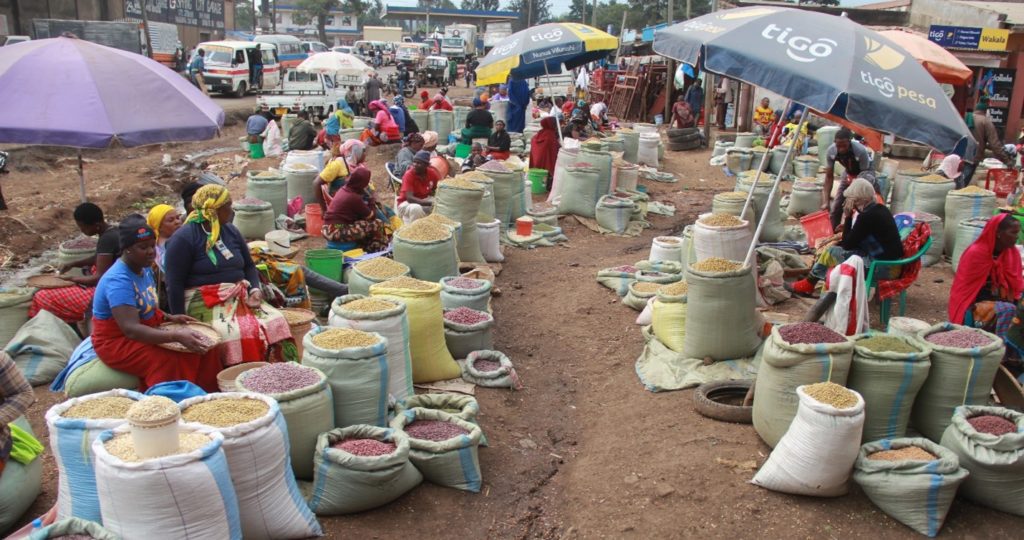
The Governments of Canada and Switzerland and the Bill and Melinda Gates Foundation have funded various initiatives in building sustainable agri-food systems and promoting economic growth in African countries including Tanzania through the Pan-Africa Bean Research Alliance (PABRA). Currently, the funding is towards projects on Improving Bean Production and Marketing in Africa and Accelerating Variety Improvement and Seed Systems in Africa. PABRA implements these initiatives through ‘’Bean Corridor’ model to unlock production bottlenecks including access to quality seed of improved varieties, quantity, and quality of grains and ultimately to satisfy the consumer demand. The corridor defined the breeding pipeline through the demand led breeding to respond to the market requirements and product profile e.g. yellow bean product profile 9abdc5_4427caccbb9246409a3b4f19118e6a1d.pdf (demandledbreeding.org).
Deploying the Bean Corridor approach in Tanzania
The model helps to connect all bean value chain actors from various nodes (research, seed producers both formal and informal, farmers, grain traders, input suppliers, mechanization, finance) from production to consumption understanding various gender challenges and opportunities. Partnering with key bean value chain actors through bean business platforms has opened business opportunities by understanding the grain demand in terms of bean type, quantity, quality, and important traits for consumers to influence the priorities of the breeding program.
Through the Bean corridor approach, value chain actors were mapped on three bean corridors across Tanzania, (figure 2) which includes, Yellow (with wider coverage), Red mottled and Sugar while red kidney and Kablanketi coming up. The Bean corridors are led by private firms connected to smallholder producers who have market information on the market type, quantity, and quality of beans demanded.
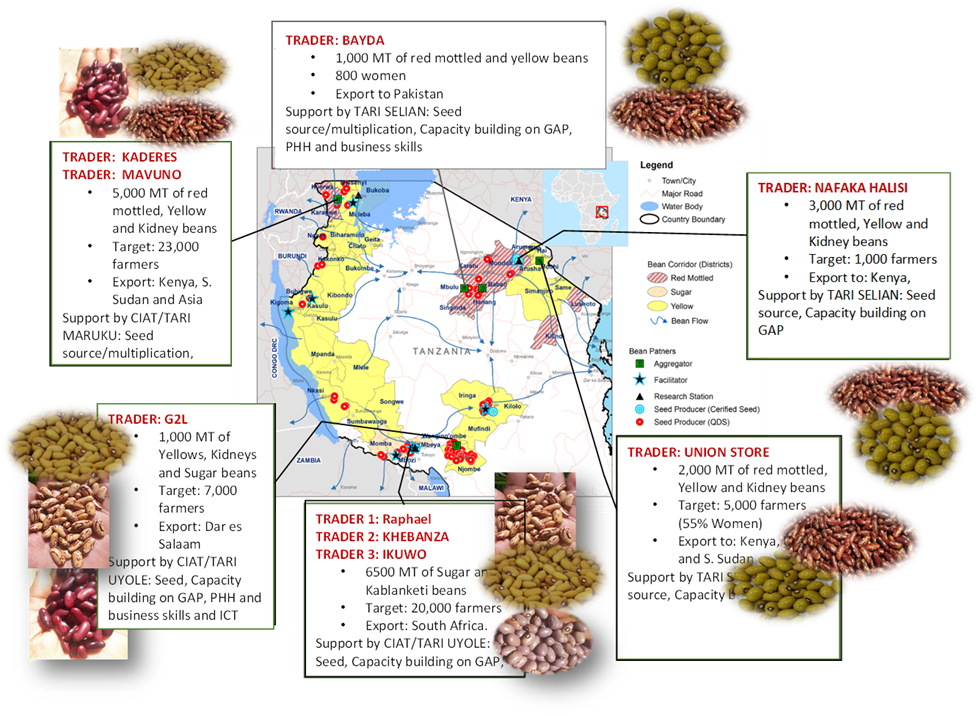
Demand Led breeding
Common beans vary in seed sizes, shapes, colors, and patterns. These are importance traits to traders and consumers. Through the multi-stakeholder bean business platforms, demanded grain types and varieties are identified and prioritized. Variety development by researchers responding to the identified gap follows. As a result of in-country crosses and breeding lines introduced by the Alliance of Bioversity International and CIAT breeding hubs in Africa and the Americas (in Uganda and Cali) between 2018 to 2021, the Tanzania Agriculture Research Institute (TARI) in partnership with the Alliance-PABRA released 15 farmer and consumer demanded varieties (see figure 3). These released varieties are high yielding, micronutrient-rich (high in iron and zinc) and climate-smart – early maturing (67- 110days), drought, diseases, and pest tolerant varieties. 67 percent of the recently released varieties are yellow, red mottled, sugar, red kidney and Kablanketi (purple) responding to the existing bean corridors in Tanzania.

Figure 3: Newly released varieties
Private sector partnership to multiply quality seed
Through the bean business platforms, aggregators share information on demand for grain/varieties to contracted farmers. Both parties come up with seed criteria to ensure premium quality. The linkage between grain aggregators and producers opened business opportunities to other value chain actors such as seed producers, input suppliers, financial institutions, mechanization, and researchers as feedback on the released varieties are noted for further improvements. In seven years (2015-2021), seed companies producing certified class have grown from zero to 15 (small and medium companies) with three women led seed producer enterprise. The number of Quality Declared Seed (QDS) producers increased from 26 to 58 (48 individuals and ten farmer organizations). The quantity of certified seed and QDS produced has increased from 542 tons in 2015 to more than four times by 2018 (2,510 tons) and more than three times in 2020 (1932 tons). In 2021 seed production was highly affected by heavy rains and 413 tons was obtained. The number of farmers accessing seed increased from 135,675 to 2,379,080 cumulatively by 2021.
Promotion of gender responsive technologies
Women play a significant role in the agricultural labor force and in agricultural activities, hence the need to priorities technologies that ensure they still take part in production.
TARI bean program in collaboration with the Alliance through PABRA has promoted various gender-responsive technologies for pre- and post-harvest among them use of both organic and inorganic fertilizers, seed dressing chemicals, multicrop threshers (MCTs), planters, pests, and disease management, metallic silos, hermetic bags etc. TARI and the Alliance is working with Crop Bioscience Solution to promote mechanization services bundled with improved seed, Good agronomic practices (GAP) and information that are climate smart in Manyara region reaching 6,500 acres (650 farmers of which 61 are female). Farmers preferring bundled services noticed an increase in productivity from 750kg/ha to 1,150kg/ha. In Mbulu district within Manyara region, the projects collaborated with BAYMAC company to facilitate the last mile delivery of bundled services of seed of improved varieties, fertilizers, and chemicals to farmers on both cash and credits. In addition, TARI and the Alliance partnered with Imara Tech Ltd and GrainPro company from Kenya to promote postharvest technologies (MultiCrop Thresher and Solar bubble driers respectively) across Tanzania. Between 2019-2021, more than 400 MCTs were sold to different users (23% being women) creating job opportunities for youth as operators and transporters from one point to another as they offer services. With the help from Imara Tech and buyers, it is approximated that one MCT can save about 50 farmers per season. The MCT has the capacity to thresh and clean between 800 to 1,000kg if beans are well dried (25% moisture) with a team of five operators in an hour compared to 14 people doing the same work manually for 10 hours. Six solar bubble driers were purchased and distributed to three farmer groups, two seed companies and two processors to support effective drying of seed and grain during the rainy season. Solar bubble driers and MCT proved to be essential in helping the farmers to get quality grain, reducing postharvest handling activities time spent especially for women while creating employment for youths.
Increased bean productivity
Overall, the support to bean work in Tanzania has seen an increase in bean production from less than 333,040ton in 2003 to 943,409ton in 2020, productivity from 0.484ton/ha to 1.3437ton/ha in less than in the same period (figure 4). The increase in productivity per unit area and quality of grains, translated to an increase in income for famers. For example, farmers in Mbulu district who are using improved technologies such as seed, and GAP received a price of US$ 0.7 – 0.721 compared 0.437 to 0.48 per Kg.
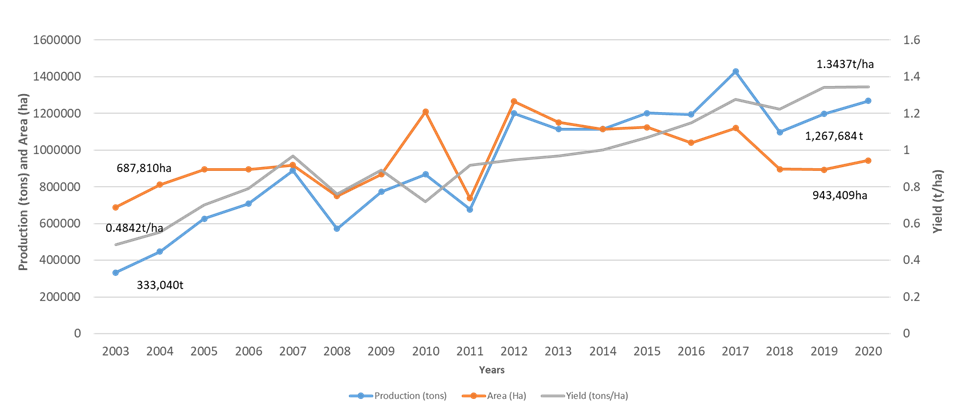
Market opportunities for micronutrient beans
Complementary initiatives in collaboration with various actors from nutritional and livelihood programs supported promotion of six varieties of biofortified beans. Local Government Authorities, Ministry of Education have been instrumental in promoting the benefits of High iron and Zinc bean (HIB) varieties with schools as entry points to the community farmers particularly farmers around schools (figure 5). The pilot phase started with twenty-two schools in five districts in 2018, later expanding to 107 schools in seventeen districts by end of 2018, 259 schools in 19 districts in 2019 and 492 schools (238,972 children; 51% being girls) in twenty-three districts by 2021. The school feeding approach has pulled different development partners to support the dissemination of biofortified bean varieties across Tanzania among them district councils, NGOs (Project Concern International, Save the Children, World Vision International, CARITAs, Actions for Development Program- Mbozi, Food and Agriculture Organization, the Global Alliance for Improved Nutrition and HarvestPlus) integrating biofortified bean varieties in their nutritional program. To ensure effective support on improving the diet for school children and community in general, the Government of Tanzania in collaboration with other actors developed two guidelines in 2020 for national biofortification [1]crops and for meals services and nutrition for primary schools [2]
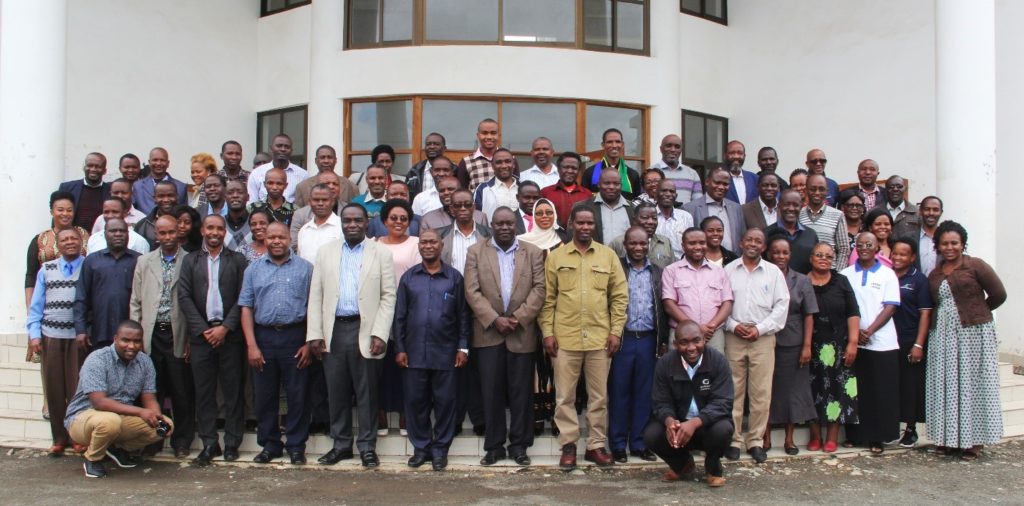
Between 2018-2021, the initiative supported four small entrepreneurs (women led) to produce bean porridge flour, biscuits, and packed grains. The raw materials used for processing are biofortified maize (provitamin A) and beans (rich in Iron and Zinc). The products are promoted and sold through various channels such as supermarket, shops, community gatherings, radio, and TV programs, food fairs and exhibitions (figure 6). On average, the sales per months ranges from 3 to 3.5 tons. Consumers for value added products are in Arusha, Kilimanaro, Dar es Salaam, Bukoba and Mwanza.
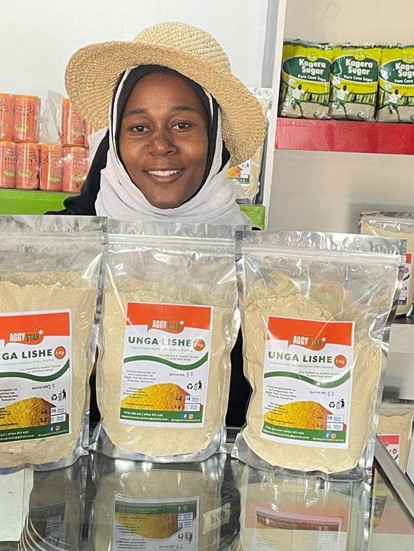
Catalyzing investments from other stakeholders
To meet the demand for quality grain by traders, exporters and processors, TARI together with partners are working to strengthen the bean corridors by catalyzing investments from public and private sectors, development partners, NGOs, and Governments (see Table 2).
Table 2: Stakeholders and research partners in Tanzania’s bean value chain
| Region | Off-taking and uses | Supporting TARI Center | Dev Part (NGO/CBO) | District Council | Private Co. | Compleme ntary Projects | No of varieties | Household Beneficiaries |
| Kigoma | WFP, local traders, home consumption | Maruku | 1 | 4 | 3 | 2063 | ||
| Kagera | KADERES, MAVUNO, Local traders, home and schools’ consumption | Maruku | 2 | 2 | 3 | 1 | 7 | 29000 |
| Mara | Local traders, home and schools’ consumption | Maruku | 1 | 4 | 1 | 2806 | ||
| Manyara | Union Store, Nafaka Halisi, local trader, home consumption | Selian | 3 | 2 | 3 | 2 | 7 | 4686 |
| Arusha | Nafaka Halisi, Union Store, local trader, home and schools’ consumption | Selian | 2 | 3 | 2 | 2 | 4 | 135000 |
| Kilimanjaro | Union Store, Nafaka Halisi, local trader, home consumption | Selian | 1 | 1 | 1 | 2 | 6 | 3500 |
| Tanga | Local trader and home consumption | Selian | 1 | 2 | 0 | 1 | 2 | 7066 |
| Morogoro | Local trader and homeconsumption | Selian | 1 | 0 | 1 | 1 | 3 | 5996 |
| Iringa | Local trader, home and schools’ consumption | Uyole | 4 | 1 | 1 | 1 | 6 | 25350 |
| Njombe | G2L, local trader, homeand schools’ consumption | Uyole | 2 | 2 | 0 | 1 | 4 | 15230 |
| Mbeya | Raphael Group Ltd, Kebhandnza Marketing Co, Rogimwa Agri Company, Local trade, home, and school consumption | Uyole | 1 | 1 | 3 | 1 | 5 | 18100 |
| Songwe | Home consumption, schools & local trade | Uyole | 2 | 2 | 1 | 0 | 6 | 13000 |
| Rukwa | Ikuwo Enterprise and local trade | Uyole | 1 | 0 | 1 | 0 | 3 | 6000 |
| TOTAL | 267797 |
In the wake of COVID-19 pandemic, PABRA with partners developed digital platforms for both training and information sharing which have become useful in connecting with the network members including smallholder farmers and their organizations. In Tanzania, the WhatsApp platforms comprising of 194 group members, allowed different value chain actors to share updates, research information, solutions to field challenges (pests and diseases), technologies, products, markets for produce, events such as field days and exhibitions. Using other digital application, meetings and training have also been conducted and ensure activities are implemented as per plans.
The prospects in future
In the future, TARI and partners are looking forward to upgrading the bean value chains by strengthening the bean corridors through:
- Demand led breeding focusing on major bean types e.g., yellow, red mottled, sugar, red kidney and kablanket.
- Catalyze public and private investments and building business cases for the development of the value chains of highly nutritious, affordable, and convenient bean-based food.
- An inclusive and impactful demand-led seed systems supported by inclusive digital information and learning platforms.
- Facilitate and catalyze business to business interactions targeting small and medium enterprises and peer mentoring targeting women and youth.
- Testing and expanding climate smart agriculture technologies including bundling farmer and consumer demanded varieties, agronomic management, climate information services supported by efficient linkages to profitable market and financial inclusion.
- Smallholders centered Agri- mechanization through linkages with service providers.
- Expanding the consumption of high and zinc rich beans by vulnerable groups e.g., homegrown school feeding
[1] https://www.kilimo.go.tz/uploads/dasip/Bio_English_Short_version_new2.pdf
[2] https://www.moe.go.tz/sw/publications/guidelines-and-circulars-miongozo-na-nyaraka.

